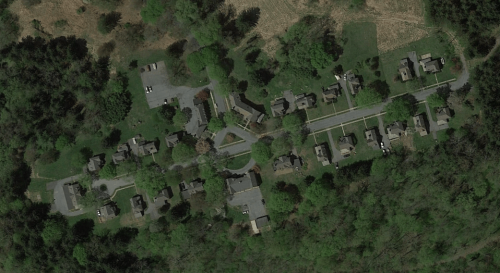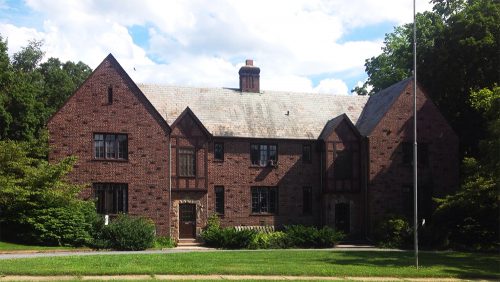Conestoga Township: The Historic Village at Safe Harbor
Safe Harbor Village Drive
Conestoga, PA
1929-1932
In 1846, Reeves Abbott & Company from Philadelphia selected the Safe Harbor area to build the Safe Harbor Iron Works. The location for the industry was ideal with the downriver navigation and canals on both the Susquehanna and Conestoga Rivers. Construction of the Historic Safe Harbor Village and Iron Works required about two years, and production began in August 1848.
The rolling mill was the largest of all the structures. It covered over an acre of ground and stood on the site of the present Safe Harbor Park’s tennis courts. Employees for the company numbered about 250. The housing challenge created by this influx of people into a rural community was solved by the iron company building the Historic Safe Harbor Village containing over 70 duplex frame dwellings, complete with a system of streets.

That village deteriorated after the ravages of a flood that washed out the bridge crossing to the other side of the river where the canal boats were located. This stopped transportation of the materials needed for production, as well as goods going to market. Two original houses remain on Groff Street, located off Main Street; however, they have been modified.
In the late 1920s, strangers appeared in the area with offers to buy property. Rumors quickly spread that some project was in the offing. Newspaper announcements stated that a huge hydroelectric dam was to be built across the Susquehanna at Safe Harbor.

The decision to proceed promptly with the project was a fortunate one for Lancaster and York Counties. The much needed jobs and the large orders for material were a boost to the Depression Era. Safe Harbor reached its greatest population with 4,000 workers at the height of construction. Residents of Safe Harbor sent a petition to the district attorney charging “bootleg whiskey is being sold openly and freely and that gambling is rampant.” This exciting period came to an end with the completion of the hydro project, and the community became quiet once again.

Today’s present Safe Harbor Village is a planned community of houses located a few hundred yards south of the site of the Historic Safe Harbor Village. Twenty one Tudor-style brick houses and two office buildings were designed for workers, offices, and administrative headquarters associated with the Safe Harbor Dam and Electric Power Plant.
Work on this project was begun in 1929; most aspects were completed by 1932. The village consists of an orderly arrangement of brick and half-timber houses designed by architects commissioned by the Safe Harbor Power Corporation.

The condition and overall original design of Safe Harbor Village are immaculate. This is considered one of the more unusual projects of a “planned community” built in Lancaster County in the first half of the 20th century.
Historic Conestoga Township Architectural Tour
This was an edited excerpt from the Historic Preservation Trust of Lancaster County’s 2004 Historic Conestoga Township Architectural Tour book. Click here to purchase a hardcopy of this excellent 31-page publication.

You can read more about Safe Harbor area including the Safe Harbor Dam by clicking here.
Historic Preservation Trust of Lancaster County

The Trust was established in 1966 to help “stem the rapid destruction of historic properties in Lancaster County.” Through the years, the Trust has been active in helping to preserve many historic properties in Lancaster County that contribute to their respective communities as unique places for people to live, work, and play.
Our equation for success has been working for over 50 years. Look around you and know that our advocacy and direct action have resulted in saving hundreds of historic structures and other sites throughout the county. The flip side is that not everything can and should be saved. The Trust continually faces this delicate balance and works closely with all parties involved to reach an equitable decision for all. Sadly, it sometimes takes an irreplaceable loss to a community before preservation moves higher on the priority list.





